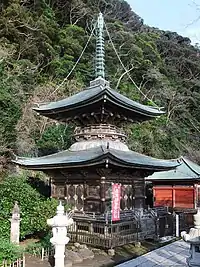| Nago-dera 那古寺 | |
|---|---|
.jpg.webp) Kannon-dō (Main hall) | |
| Religion | |
| Affiliation | Buddhism |
| Deity | Senju Kannon |
| Rite | Shingon Chizan Sect |
| Location | |
| Location | 1125 Nago, Tateyama, Chiba Prefecture |
| Country | Japan |
| Geographic coordinates | 35°1′32″N 139°51′28.5″E / 35.02556°N 139.857917°E |
| Architecture | |
| Founder | Empress Genshō (?) |
| Completed | 717 (?) |
| Website | |
| http://www.bandou.gr.jp/33.htm | |

Nago-dera (那古寺) is a Buddhist temple located in the city of Tateyama in southern Chiba Prefecture, Japan. The temple is also called Nago-ji using the alternate pronunciation of the final Chinese character in its name, or the Nago Kannon (古寺観音), after its primary object of worship.
Location
Nago-dera is located on the middle slopes of Mount Nago at the southern tip of the Bōsō Peninsula, and is surrounded by forest. The area around the temple has important stands of sudajii Castanopsis, the tabunoki machilus species of laurel, the yabunikkei species of cinnamomum, camellia and the himeyuzuri species of daphniphyllum.[1]
History
According to temple legend contained in the Nago-dera engi text,[1] Nago-dera was founded by the wandering holy ascetic Gyōki around 717 AD to pray for the recovery of Empress Genshō from an illness. However, no historical documents have survived to substantiate this legend, and the history of the temple is thus uncertain. Most of the temple was destroyed by a fire in 1703, and its oldest existing structures are its Hondō (本堂) main hall (1732) and Tahōtō (多宝塔) pagoda (1761), both of which are registered as Chiba Prefectural Important Cultural Properties.[2]
Nago-dera was used as a place of worship by successive samurai clans, starting with Minamoto no Yoritomo (1147–1199), Ashikaga Takauji (1305–1358), Satomi Yoshizane (1412–1488) and members of the Tokugawa clan.[3]
The temple currently belongs to the Shingon Chizan Sect of Japanese Buddhism. Its Gohonzon (primary object of veneration) is a bronze statue of Senju Kanzeon Bosatsu (千手観世音菩薩, Senju Kanzeon Bosatsu),[1] which dates from the Kamakura period. This statue is a national Important Cultural Property.
Order in Buddhist pilgrimages
Nago-dera is the 33rd and last in the Bandō Sanjūsankasho, a pilgrimage circuit of 33 Buddhist temples in the Kantō region of eastern Japan dedicated to the Bodhisattva Kannon.